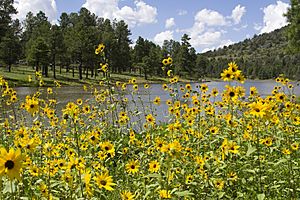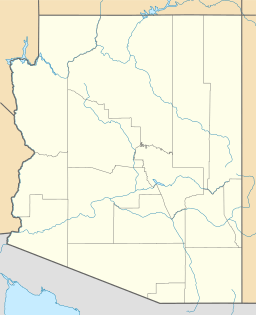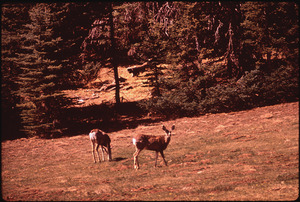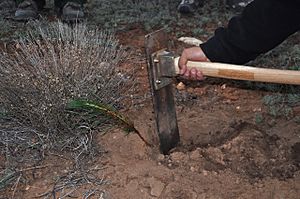Kaibab Plateau facts for kids
Quick facts for kids Kaibab Plateau |
|
|---|---|
| Buckskin Mountain, Buckskin Plateau, Kaibab Mountain | |

Kaibab Plateau viewed from space, April 2006
|
|
| Highest point | |
| Elevation | 8,701 ft (2,652 m) |
| Prominence | 3,580 ft (1,090 m) |
| Isolation | 70.44 mi (113.36 km) |
| Listing | List of mountain peaks of Arizona |
| Naming | |
| Etymology | Native American word meaning "mountain lying down" |
| Geography | |
| Location | Coconino County, Arizona and Kane County, Utah in the United States |
The Kaibab Plateau is a large, flat area of land, like a high plain. It is mostly in Coconino County, Arizona, but a small part reaches north into Kane County, Utah. People also call it the Buckskin Mountain or Buckskin Plateau. The name "Kaibab" comes from a Native American word meaning "mountain lying down."
Contents
Exploring the Kaibab Plateau

This huge plateau is part of the even bigger Colorado Plateau. To its south, you'll find the amazing Grand Canyon. The highest parts of the Kaibab Plateau are about 9,200 feet (2,800 meters) high.
The plateau is split between the Kaibab National Forest and the "North Rim" part of Grand Canyon National Park. Deep canyons carved by the Colorado River form the eastern and western edges of the plateau. High cliffs mark its northern boundaries.
Winters here get a lot of snow, sometimes more than 17 feet (5 meters)! This makes it a great place for backcountry Nordic skiing and snow camping.
The Kaibab Plateau is covered in thick forests of aspen, spruce-fir, ponderosa pine, and pinyon-juniper woodland. These cool, green forests are a big change from the dry, desert-like lands around them.
Animals of the Plateau
The cool forests of the plateau are home to the Kaibab squirrel. This special squirrel is endemic, meaning it lives only in this region and nowhere else in the world!
Other animals you might see include deer, turkey, cougar, and bobcat. The Kaibab deer are especially famous because of big changes in their population a long time ago. This story shows how humans can affect nature.
Plateau Features and Size
The Kaibab Plateau covers about 1,152 square miles (2,984 square kilometers) that are higher than 6,000 feet (1,800 meters). The highest point is about 9,200 feet (2,800 meters) above sea level.
The southern part of the plateau, near the Grand Canyon, ranges from 8,800 feet (2,700 meters) down to just under 6,000 feet (1,800 meters).
One interesting part of the plateau is called the Esplanade, or "Sand Rocks" by local cowboys. This area has a hard layer of red sandstone, which is a striking feature of the plateau.
The Kanab Creek Canyon, with its tall, straight walls, forms the western edge of the plateau. This canyon acts like a natural barrier for most animals. The eastern edge is marked by the Houserock Valley, which is a marble platform formed by a large fold in the rock layers.
Kaibab Plateau Climate
The Kaibab Plateau has different weather throughout the year. In late summer, during the monsoon season, it gets rain and thunderstorms. Winters bring heavy snow. Early summer is usually drier.
From 1925 to 1936, the plateau received about 26.57 inches (67.49 centimeters) of rain and snow each year. In winter, snow often piles up to 8 to 10 feet (2.4 to 3 meters deep). June is the driest month, followed by May and early July.
Snowstorms can happen between May and September in the highest parts of the plateau.
The Story of the Kaibab Deer
At the start of the 1900s, something interesting happened with the deer on the Kaibab Plateau. Before 1905, there were an estimated 4,000 mule deer living there. This number was never officially counted, but it's the number people generally use.
In 1906, President Theodore Roosevelt created the Grand Canyon National Game Preserve. The goal was to protect and help the deer population grow. Before this, sheep, cattle, and horses had eaten a lot of the plants on the plateau since the 1880s. Ranchers had also killed many natural predators of the deer, like mountain lions and wolves.
When the game preserve was made, most farm animals were moved away. The biggest change was that deer hunting was banned. The United States Forest Service also worked to protect the deer by killing more of their natural predators. Between 1907 and 1939, they reported killing many mountain lions, wolves, coyotes, and bobcats.
Deer Population Changes
The deer population grew a lot in the early 1900s. Some people estimated there were as many as 100,000 deer by 1924! However, this number might have been much higher than the actual number.
Soon after, the deer population started to drop. There were too many deer for the amount of food available, and they began over-browsing the plants. Many deer started to starve to death.
After some legal arguments between the government and Arizona, hunting was allowed again to reduce the deer numbers. But hunters could only kill a small part of the starving deer. The land itself was damaged, and it could no longer support as many deer as before.
Understanding Prey and Predator Balance
When scientists called ecologists studied the area, they used the Kaibab deer story as an example. They thought it showed how removing the deer's natural predators led to too many deer. This caused the deer to eat too much of the plateau's resources. Some ecologists said this showed how important it is to keep animal populations balanced with the environment's ability to support them.
The Kaibab story also teaches us that when humans try to protect wildlife, it's complicated. Changes can happen fast, and their effects can last for many years. Today, the Arizona Game Commission manages the area. They control the numbers of deer and predators and issue hunting permits to keep the deer population healthy and balanced with the land.

The Kaibab deer story became famous in the 1920s because of the sudden increase and decrease in their numbers. This story also helps us learn how scientific studies and ideas about history can teach students today.
At first, textbooks taught that controlling predators was the main reason the deer population changed so much. People thought that many predators were stopping the deer from growing in number. So, rules were made to reduce predators, hoping the deer population would get bigger.
However, as scientists continued to study, an ecologist named Graeme Caughley suggested that predator control alone could not have caused the huge deer population boom. He believed other things like climate, grazing by other animals, and conservation policies had a bigger impact on the deer.
Caughley's ideas made teachers and scientists wonder what to teach in ecology and biology classes. Because of this, the Kaibab deer story stopped being used as a simple example of how prey and predator populations interact. This is important for science because it shows that events, like the Kaibab deer situation, are not always simple. They can have many different reasons and opinions, which helps teachers show how rich and complex scientific discussions can be.
The Kaibab deer story has changed how science is taught in textbooks. It encourages students to ask more questions about ecology and biology. Also, students now learn that when humans get involved in nature, it can have big effects on animal populations and how they develop in certain areas.
See also
 In Spanish: Meseta de Kaibab para niños
In Spanish: Meseta de Kaibab para niños





